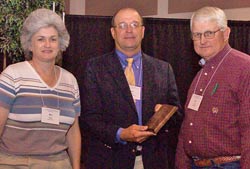
CK Ranch of Kansas was recognized as a nominee for BIF Commercial Producer of the Year. Receiving the award from 2005 BIF President Jimmy Holliman (center) are Mary and Ray Negus.
2005 Commercial Producer of the Year Nominees
CK Ranch | Diamond V Ranch | Dover Ranch | Gaines Farm | Hillwinds Farm | Krupps Farm | Jack and Ila Mae Larson | Mule Creek Ranch | Paxton Ranch | Pontious Farms | Prather Ranch | Shovel Dot Ranch | Wintergreen Farm
CK Ranch
Owner – John Vanier; Manager – Ray Negus
Kansas
 CK Ranch of Kansas was recognized as a nominee for BIF Commercial Producer of the Year. Receiving the award from 2005 BIF President Jimmy Holliman (center) are Mary and Ray Negus. |
CK Ranch is located in the Smoky Hills region of Saline and Ellsworth counties. This particular region of Central Kansas is known as one of the best cow-calf grazing areas in the country. The CK Ranch has approximately 15,000 acres of native pastures and 1,000 acres of tillable, dry land crop and alfalfa ground. Crops grown include grain sorghum, oats and triticale, all for supplementing the cowherd. CK Ranch was founded by JJ Vanier, Father of Jack and Grandfather of John. He was a salesman for Abilene Flour Mill and eventually became owner of Western Star Mill in Salina. His first purchase of land was made in Ellsworth County in 1933 when he purchased the 5,600 acre Root Ranch. This is now the ranch headquarters. As additional ranches became available, they were obtained and now CK contains about 15,000 acres, most of which are continuous.
CK was first stocked with steers. The first Herefords arrived on the ranch in 1936. In the 1950’s the ranch had almost 2,000 head of registered cows and registered approximately 1,200 calves. Now the commercial herd runs from 600 to 950 Hereford and Red Angus cows, depending on market and grass conditions and 175 to 200 registered Hereford and Red Angus cows. The cows calve in the spring with 100 to 200 heifers calving in January and February, the seedstock herd in February and March, and the commercial cows in March and April. Depending on economics, steers are either retained through harvest, back-grounded and sold, or sold at weaning directly to buyers. Heifers not retained for in-herd replacements are sold to other ranchers as replacements or sold as feeder heifers. One of the primary purposes of the commercial cows is to provide a testing herd for both Hereford and Red Angus genetics.
CK participates in the American Hereford Association’s Whole Herd Total Performance Records (TPR) and the National Reference Sire Program (NRSP), and does structured carcass testing with Mill Creek Ranch.
CK Ranch was nominated by the American Hereford Association.
CK Ranch | Diamond V Ranch | Dover Ranch | Gaines Farm | Hillwinds Farm | Krupps Farm | Jack and Ila Mae Larson | Mule Creek Ranch | Paxton Ranch | Pontious Farms | Prather Ranch | Shovel Dot Ranch | Wintergreen Farm
Diamond V Ranch
Butch and Renee Jochim
North Dakota
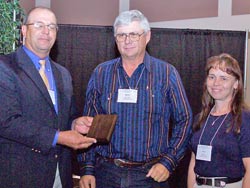 Diamond V Ranch of Selfridge, N.D., was recognized as a nominee for BIF Commercial Producer of the Year. Receiving the award from 2005 BIF President Jimmy Holliman (left) are Butch and Renee Jochim. |
Diamond V Ranch is located near Selfridge, North Dakota. The ranch lies just across the stateline in the rolling grasslands and breaks north and west of McLaughlin, South Dakota. Butch Jochim and his family have operated the Diamond V Ranch at this location since 1975, when he joined his father, Valentine, who started ranching at this location in 1958. The ranch includes both deeded land and land leased from the Bureau of Indian Affairs at the Standing Rock Reservation. In addition to the cattle, Butch plants 1,200 acres of wheat each year.
The cowherd is made up of approximately 700 head of Angus based cows, both red and black. Purebred Limousin bulls are used on the cowherd with the resulting calves born in April and May each year. Calves are marketed annually on the day after Columbus Day at the McLaughlin Livestock Auction. For the past several years, the red calves have been fed for the Laura’s Lean Beef program by Wulf Limousin Farm of Morris, Minnesota where Butch has purchased a number of herd bulls. The Diamond V calves top the market each year which is a testament to the quality of seedstock that Butch demands for his commercial program.
Diamond V Ranch is nominated by the North American Limousin Foundation.
CK Ranch | Diamond V Ranch | Dover Ranch | Gaines Farm | Hillwinds Farm | Krupps Farm | Jack and Ila Mae Larson | Mule Creek Ranch | Paxton Ranch | Pontious Farms | Prather Ranch | Shovel Dot Ranch | Wintergreen Farm
Dover Ranch
Dover Sindelar and son, Frank
Montana
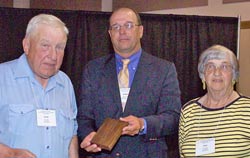 Dover Ranch of Montana was recognized as a nominee for BIF Commercial Producer of the Year. Receiving the award from 2005 BIF President Jimmy Holliman (center) are Dover and Irene Sindelar. |
The Dover Ranch was founded in 1881 when John Dover homesteaded on an island in the Yellowstone River several miles below Billings, MT. John’s wife, Mary, homesteaded other area land in 1904 which became the present site of the Dover Ranch.
Shorthorn cattle were purchased from a neighbor in the 1880’s and have been run continuously on the ranch for over 100 years. The present operators grew up with Shorthorn cattle, make their living from them, and in doing so have developed a very strong ideal of the breeds purpose, abilities and potential.
Dover Ranch operates on 12,000 acres; 1500 acres are seeded with Crested Wheatgrass and divided into 20 separate breeding pastures. Another 1,000 acres produce hay and grain for cattle. The remainder is in native pastures. Fifteen miles of pipeline supply stock-water to all pastures. After being reduced by years of drought, the cowherd is at 300 head. The first calf heifers are AI’ed to light birth weight Red Angus bulls to start calving Feb. 1st, three weeks ahead of the cowherd. Most of the Shorthorn bulls used on the cowherd are raised at Dover Ranch.
A comprehensive pre-conditioning program is followed prior to shipping weaned calves. Top bull calves and heifers are fed a growing ration through the winter for with-in herd replacements and outside sales.
Selection of cattle using objective data, rangeland improvements, and stock-water development has all been major contributions to the success and longevity of Dover Ranch.
The American Shorthorn Association nominated Dover Ranch.
CK Ranch | Diamond V Ranch | Dover Ranch | Gaines Farm | Hillwinds Farm | Krupps Farm | Jack and Ila Mae Larson | Mule Creek Ranch | Paxton Ranch | Pontious Farms | Prather Ranch | Shovel Dot Ranch | Wintergreen Farm
Gaines Farm
Hank and Harold Gaines
Alabama
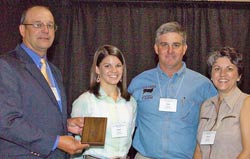 Gaines Farm, Autaugaville, Ala., was recognized as a nominee for BIF Commercial Producer of the Year. Receiving the award from 2005 BIF President Jimmy Holliman (left) are Ginger, Hank and Dianne Gaines. |
Gaines Farms is located nearly two miles north of the Alabama River close to Autaugaville, Alabama. This family-owned and operated diversified farm produces beef cattle, cotton, peanuts, hay, timber, and small grains. Gaines Farms has been in business for over 30 years managing cattle and row crops on 1,600 acres of owned and leased land. The cow herd is made up of about 250 mature females, which are predominantly Angus, Simmental, and Charolais crosses, grazing approximately 600 acres of pasture land. Angus, Charolais, Simmental, or SimAngus bulls are utilized for the crossbreeding program.
Calving begins in late September with first calf heifers and continues with mature cows through the first of November. Fall calving allows for cereal grains, which are over-seeded on row crop land, to be utilized during peak lactation for the cow herd. This matches by-product feed resources and forage production for optimal marketing of feeder cattle. Replacement heifers are chosen from within the herd, where approximately 30-40 heifers are retained for breeding each year.
Comprehensive performance and financial information is analyzed on this herd annually to assist in selection and culling decisions. This diversified operation intermingles all of the agricultural entities to the benefit of all, but each segment of Gaines Farm is managed separately. All cattle are raised under beef quality assurance guidelines to ensure a safe consistent product for the consumer. Gaines Farms is continually implementing innovative programs into the operation. It is the dedication of the family that accounts for the success of the operation.
The Alabama Beef Cattle Improvement Association nominated Gaines Farm.
CK Ranch | Diamond V Ranch | Dover Ranch | Gaines Farm | Hillwinds Farm | Krupps Farm | Jack and Ila Mae Larson | Mule Creek Ranch | Paxton Ranch | Pontious Farms | Prather Ranch | Shovel Dot Ranch | Wintergreen Farm
Hillwinds Farm
Tim and Cathy Sutphin
Virginia
Hillwinds Farm is located near Dublin, Virginia, in the southwestern portion of the state. As part of the Blue Ridge Mountains, cattle thrive on the native grasses and legumes.
While growing up on a farm with a small cowherd Tim acquired his interest in beef production. Tim owned his first cow when he was five years old, and has continued to build his herd size every year since. Tim and Cathy have built their lives around beef cattle. Today, the operation consists of 1,047 owned acres and 800 leased, all in pasture and hay.
Currently Hillwinds Farm maintains 625 brood cows, of which 390 calve in the spring and 235 calve in the fall. The cows are commercial and crossbreds. Angus, Simmental and Angus x Simmental cross bulls are used. Ideally, the operation strives to produce a _ Angus x _ Simmental calf. Hillwinds makes extensive use of estrous synchronization, artificial insemination, and retained ownership to slaughter. Tim and Cathy also purchase, background, and retain ownership an additional 500 source-verified calves each year.
In 2004, as operator of the Southwest Virginia Bull Test Station, Hillwinds Farm contract fed 200 bulls for 43 consignors. Another enterprise is a 160-head ewe flock which started as a 4-H project. Tim and Cathy have four children: Laura, Allison, Caroline and Heath, all of which are involved in agriculture through 4-H, FFA, and the farm. The children are Hillwinds Farm’s main value-added commodity.
Hillwinds Farm was nominated by the Virginia Beef Cattle Improvement Association.
CK Ranch | Diamond V Ranch | Dover Ranch | Gaines Farm | Hillwinds Farm | Krupps Farm | Jack and Ila Mae Larson | Mule Creek Ranch | Paxton Ranch | Pontious Farms | Prather Ranch | Shovel Dot Ranch | Wintergreen Farm
Krupps Farm
David and Steven Krupps
Illinois
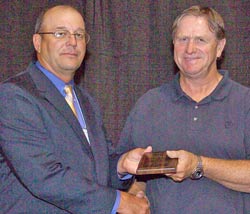 Krupps Farms, Illinois, was recognized as a nominee for BIF Commercial Producer of the Year. Receiving the award from 2005 BIF President Jimmy Holliman (left) is David Krupps. |
Krupps Farms is a partnership between brothers, David and Steven Krupps, consisting of 2,375 acres of which 700 acres are permanent pasture in Brown County. Two hundred commercial beef cows are maintained by David and Steven. The Krupps Brothers have been farming since graduating with business degrees from Spoon River College and Illinois State University.
Though initial emphasis was placed on swine production, economics caused them to expand their cattle operation. David and Steven increased both the cow-calf herd and the grain farming operation. The business degrees have been a valuable asset as grain and livestock prices stabilized and efficiency became increasingly important.
The beef cattle operation started with purebred Angus cows with mostly continental breeds of bulls (Simmental, Charolais, and composites) used on the Angus cows to increase growth and maternal milk. Recently, they have utilized Angus bulls to increase the consistency and carcass desirability of their calf crop. Most of the bulls used in the breeding herd were purchased from the Western Illinois University Test Station.
The 700 acres of permanent pastures consist of grass-legume mixtures with rotational grazing used to increase pasture carrying capacity. Following two crops of hay production, these fields are grazed in the late summer and early fall. Corn crop residue is utilized in the fall to extend the grazing season prior to fall tillage. Several of the pastures could be used as part of their grain farming; however, they have been left in grass to prevent erosion on the soils that have more slope.
Calves are weaned at five to six months and processed through a preconditioning program. After the calves are processed they are backgrounded for a short time prior to selling through a preconditioned feeder cattle sale. Annually, their calves are sought by feedlots because of their genetics for growth and health status.
The predominate winter-feed is corn silage with supplementation of grass-legume hay. Feed bunks have been constructed on several farmsteads to winter the cows, for calving and development of the replacement heifers. The brothers are continuing to monitor cost in their operation and strive to reduce the cost to produce a calf without sacrificing reproduction and production efficiency.
Conservation of the land and community involvement is of utmost importance to David and Steven Krupps. They utilize no till for all of their corn and soybean production.
David and Steve enjoy being involved in the beef industry and share their involvement through industry and community boards include serving on the Western Illinois University Bull Test Station boards for many years. In addition, several of the boards they are associated with their local fire district, school, cemetery, hunter association, Farm Bureau, Farm Service Agency, Selby Creek Hydrologic Area, 4-H advisory, Two Rivers FS and others.
The Illinois Beef Association and the University of Illinois Extension nominated Krupps Farms.
CK Ranch | Diamond V Ranch | Dover Ranch | Gaines Farm | Hillwinds Farm | Krupps Farm | Jack and Ila Mae Larson | Mule Creek Ranch | Paxton Ranch | Pontious Farms | Prather Ranch | Shovel Dot Ranch | Wintergreen Farm
Jack and Ila Mae Larson
Colorado
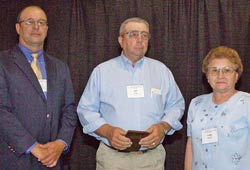 Jack (right) and Ila Mae Larson, Gill, Colo., were recognized as a nominee for BIF Commercial Producer of the Year. Presenting the award is 2005 BIF President Jimmy Holliman. |
Home base of the operation is approximately two miles east of Gill, Colorado. The cow herd is run on summer pastures several miles north of the home base. They are brought to the home base for winter grazing of cornstalks, wheat, and alfalfa. They are also calved out, branded and vaccinated before being returned to summer pastures. Weaned calves are put in our feedlot at the home base, along with about 400 purchased calves from local ranchers that they have been buying calves from for 12-15 years. Normally, their cow herd would be 500 head, but due to the drought herd inventory is down to about 400 head. They farm about 1,000 acres of irrigated land which grows corn, wheat and alfalfa. All crops except wheat are used in the cattle feeding operation. Spring-calving normally is in February and March, spreading out the family’s work load. The Hereford cowherd started in 1961. In 1973 they started crossing with Charolais bulls: experimented with a few Simmental bulls, used Gelbvieh as a cross for seven years and have basically been using Angus bulls for the past 15 years.
The Colorado Cattlemen’s Association nominated Jack and Ila Mae Larson.
CK Ranch | Diamond V Ranch | Dover Ranch | Gaines Farm | Hillwinds Farm | Krupps Farm | Jack and Ila Mae Larson | Mule Creek Ranch | Paxton Ranch | Pontious Farms | Prather Ranch | Shovel Dot Ranch | Wintergreen Farm
Mule Creek Ranch
Owner – Ron Williams; Manager – Kim Leeper
Kansas
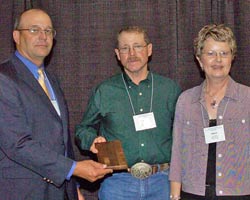 Mule Creek Ranch, Wilmore, Kan., was recognized as a nominee for BIF Commercial Producer of the Year. Receiving the award from 2005 BIF President Jimmy Holliman (left) are Kim and Sharon Leeper. |
Mule Creek Ranch is located in the unique grass country of eastern Comanche County near Wilmore, KS. For the past nine years, Kim and Sharon Leeper, and their son Cade, and his wife, Jody, have been managing Mule Creek for owner Ron Williams of Denver, CO.
The ranch runs 950 commercial Angus cows, which have been selectively bred to work in the rugged terrain of South Central Kansas. All females are bred to calve in April and May using synchronization and an intensive artificial insemination (AI) program. They keep the majority of females produced for replacement heifers; placing a lot of demand on efficiency, fertility, and marketability. The overall goal of the operation is to consistently develop sound, reproductively efficient females.
To produce this type of cattle, an intensive breeding program based on proven genetics is used. Being very disciplined in sire selection, only proven Angus bulls from Gardiner Angus Ranch are used on the commercial cowherd. Maternal EPDs are major selection criteria. Combining proven sires with an intensive AI program has allowed the development an economically efficient cowherd.
The cowherd is grazed year-round, using a rotational non-intensive grazing system. The all-grass operation consists of warm season native grasses including big bluestem, little bluestem, Indiangrass, switchgrass, sideoats grama, buffalo grass and native Eastern Gama grass. Additional supplement is provided only during winter months.
The steer calves have been marketed in a variety of ways over the past years, including retaining ownership and feeding at a commercial feedyard and selling calves on a value-based grid. They also sell a select few replacement heifers yearly through an auction of known genetics.
The Kansas Livestock Association nominated Mule Creek Ranch.
CK Ranch | Diamond V Ranch | Dover Ranch | Gaines Farm | Hillwinds Farm | Krupps Farm | Jack and Ila Mae Larson | Mule Creek Ranch | Paxton Ranch | Pontious Farms | Prather Ranch | Shovel Dot Ranch | Wintergreen Farm
Paxton Ranch
John and Jessica Warren
Nebraska
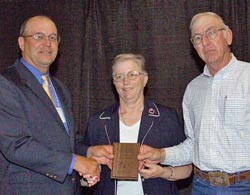 Paxton Ranch, Thedford, Neb., was recognized as a nominee for BIF Commercial Producer of the Year. Receiving the award from 2005 BIF President Jimmy Holliman (left) are Jessica and John Warren. |
The Paxton Ranch headquarters are located 20 miles South of Thedford, NE, on Highway 83 and includes another ranch 14 miles west of the headquarters. The operation consists of 36,000 deeded acres and a 9,500 acre grazing permit giving the Warren’s a total carrying capacity of 1,500 mother cows. Six hundred cow/calf pairs are trailed 14 miles north on June 1st, to be summered on the Halsey National Forest. The west place is home to 300 first calf heifers and 300 second calvers. An additional 300 pairs besides yearling steers and heifers are summered on the main ranch. The steers and cull heifers are then sent to the feedlot. Bulls are turned out around June 12th for a 55-day breeding season.
The Paxton Ranch was established in 1933 by Jessica’s father, Chester Paxton, with the purchase of 640 acres, now part of the West Place. Chester, his wife, Ida, and later John and Jessica built and expanded the ranch holdings making it what it is today – a model for successful, sustainable Sandhills cattle operations.
By studying the natural and human resources available, understanding cattle and their behavior and utilizing a little common sense, John has been an innovator in Sandhills management practices.
The Red Angus Association of America nominated the Paxton Ranch.
CK Ranch | Diamond V Ranch | Dover Ranch | Gaines Farm | Hillwinds Farm | Krupps Farm | Jack and Ila Mae Larson | Mule Creek Ranch | Paxton Ranch | Pontious Farms | Prather Ranch | Shovel Dot Ranch | Wintergreen Farm
Pontious Farms
Robert, Dan and Steve Pontious
Ohio
Pontious Farms is a family run beef operation that includes Robert along with sons Dan and Steve. The original 120 acres of the farm was purchased in 1955 and over the years has expanded to its current size of over 300 acres. The farm is located three miles east of Lancaster in central Ohio. The terrain of hills and hollows is best suited for cattle grazing instead of crop production.
The cow herd consists of 140-150 head of commercial Angus beef cows. Replacement heifers are bred by artificial insemination to start calving March 10th and the mature cows are bred to start calving in the last week of March. Artificial insemination has been used to some extent every year since the farm was purchased in 1955. A feedlot was built by the family in 1982.
Replacement heifers are selected from within the herd with the remainder of the calf crop retained and fed out on the farm. Additional feeders are purchased to achieve the feedlot’s capacity. Total head marketed ranges from 300 to 350 per year. Fed cattle are normally sold to the Excel or Smithfield plants in Pennsylvania on a high-quality based grid.
Pontious Farms was nominated by the Ohio Cattlemen’s Association.
CK Ranch | Diamond V Ranch | Dover Ranch | Gaines Farm | Hillwinds Farm | Krupps Farm | Jack and Ila Mae Larson | Mule Creek Ranch | Paxton Ranch | Pontious Farms | Prather Ranch | Shovel Dot Ranch | Wintergreen Farm
Prather Ranch
Ralphs and Rickert Families; Manager – Jim and Mary Rickert
California
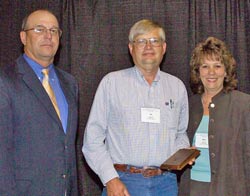 Prather Ranch, California, was recognized as a nominee for BIF Commercial Producer of the Year. Receiving the award from 2005 BIF President Jimmy Holliman (left) are Jim and Mary Rickert. Later, Prather Ranch was named Commercial Producer of the Year. |
The 28,555-acre Prather Ranch is a vertically integrated cattle business that operates in five northern California counties. The ranch headquarters was founded in the 1870’s and acquired by Walter Ralphs in 1964. Jim and Mary Rickert formed an association with the ranch in 1979.
The ranch operates a “closed herd” of 1,550 English crossbred cows. The cow herd is about 20% Angus, 20% Hereford, and approximately 60% black baldies. About 60% of the cows calve in the spring near Macdoel, California for our natural beef program. The remaining 40% calve in the fall and are certified organic. The organic herd is maintained separately, summering in the Fall River Valley and wintering in the northern Sacramento Valley. This facilitates the unique marketing programs of the Prather Ranch.
This “closed herd” concept is based on the need to maximize biosecurity. Prather Ranch supplied bovine raw materials to various pharmaceutical companies and, as a requirement, extensive record keeping and Standard Operating Procedures are in place. On the cow side, the herd was closed in 1975. Since 1990, the herd has been bred by artificial insemination or ranch raised bulls. The ranch has implemented and participates in a young sire progeny-testing program, known as Gen-Scan, by working with purebred breeders and the American Hereford and American Angus Associations.
In 1995, the ranch built a USDA inspected on-site slaughterhouse and meat processing facility. The ranch direct markets natural and organic dry-aged beef in southern Oregon and northern California. Prather Ranch Meat Company also maintains a storefront in the San Francisco Ferry Building.
Prather Ranch is nominated by the University of California – Agriculture and Natural Resources Cooperative Extension, Siskiyou County.
CK Ranch | Diamond V Ranch | Dover Ranch | Gaines Farm | Hillwinds Farm | Krupps Farm | Jack and Ila Mae Larson | Mule Creek Ranch | Paxton Ranch | Pontious Farms | Prather Ranch | Shovel Dot Ranch | Wintergreen Farm
Shovel Dot Ranch
Larry and Nickie Buell; Homer and Darla Buell
Nebraska
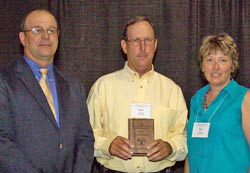 Shovel Dot Ranch of Nebraska was recognized as a nominee for BIF Commercial Producer of the Year. Receiving the award from 2005 BIF President Jimmy Holliman (left) are Homer and Darla Buell. |
Shovel Dot Ranch is a commercial cow-calf operation located in North Central Nebraska on the eastern edge of the Sandhills. The ranch was established in 1883 by Benjamin Franklin Buell (Homer and Larry’s great grandfather) and presently has the fifth generation-Larry’s daughter and son-in-law and Homer’s son and daughter-in-law involved in the ranching operation.
Shovel Dot Ranch operates about 30,000 acres, with 25,000 acres owned and 5,000 leased. Of those acres, about 2,000 are sub-irrigated meadow, 240 acres are under center pivot in alfalfa, and the rest is native grazing land.
The ranch operates three livestock enterprises: a commercial cow/calf herd, a backgrounding yard, and a stocker operation. The genetics of the cowherd is a blend of Hereford, Angus, and Hereford x Angus crosses. Cow inventory can vary from year to year but presently stands at 1,403 cows.
Cows begin calving in late April with the calving season for heifers starting a few weeks earlier. The breeding program depends on breed type of the cow. Cows are bred to either Hereford or Angus bulls to produce a cross-bred female. The calves are weaned in late September to early October and grazed on sub-irrigated meadow regrowth until November. They are moved to the backgrounding lots for winter. In early May, calves return to graze pasture until they are marketed at the local sale barn or by private treaty in mid-late summer when yearling prices are traditionally the highest in the area. During the fall, additional steers are purchased with targeted marketing dates from April 15 through August. The cows are grazed most of the year and fed hay and supplement in the winter when the snow is deep or grass runs short.
Our mission statement: “The purpose of Shovel Dot Ranch is to provide a business entity that satisfies the needs, wants, and desires of its owners and their families.”
The Nebraska Cattlemen Association and the University of Nebraska nominated the Shovel Dot Ranch.
CK Ranch | Diamond V Ranch | Dover Ranch | Gaines Farm | Hillwinds Farm | Krupps Farm | Jack and Ila Mae Larson | Mule Creek Ranch | Paxton Ranch | Pontious Farms | Prather Ranch | Shovel Dot Ranch | Wintergreen Farm
Wintergreen Farm
Martin Green
Iowa
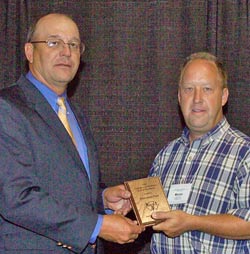 Wintergreen Farm of Iowa was recognized as a nominee for BIF Commercial Producer of the Year. Receiving the award from 2005 BIF President Jimmy Holliman (left) is Martin Green. |
Wintergreen Farm is located in east central Iowa right in the center of “corn-bean” country. Martin’s parents, Winston and Teresa, moved to Wintergreen Farm in 1958 and raised nine children on 280 acres. All nine siblings received college degrees, thanks to Winston and Teresa’s hard work. Martin is the youngest of the nine and the only one that farms. Martin’s parents kept the cow herd going while he was attending Iowa State University. After graduation Martin returned home and with family help purchased his first farm. This particular farm had an abundance of pastureland and since it was “meant for cows” the herd expanded.
Presently Wintergreen Farm has an inventory of about 170 crossbred cows, which is a large operation for the surrounding area. The genetic foundation of the herd is made up of blends of Angus, Red Angus, Simmental, and Gelbvieh genetics. Calving starts March 20-25 each spring and calves are grouped by two-week intervals. Calves are ID-tagged, weighed, and the bull calves are banded. Calving information is recorded and entered into the “Cow Sense” computer program. Cows are control-grazed on cool and warm season forages.
All heifers and some cows are artificially inseminated. Calves are preconditioned and weighed at weaning in early September. They are then backgrounded and sold in early November. Replacement heifers are kept based on “Cow Sense” records and phenotype. Cows are pregnancy-checked, vaccinated, and poured in mid-October before moving to cornstalks. Open cows are sold in October.
Wintergreen Farm was nominated by the Iowa Cattlemen’s Association.
CK Ranch | Diamond V Ranch | Dover Ranch | Gaines Farm | Hillwinds Farm | Krupps Farm | Jack and Ila Mae Larson | Mule Creek Ranch | Paxton Ranch | Pontious Farms | Prather Ranch | Shovel Dot Ranch | Wintergreen Farm